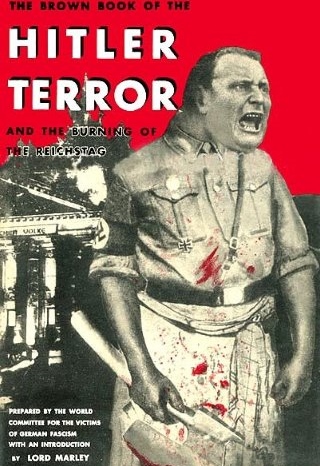click to dowload our latest edition
CLICK HERE TO SUBSCRIBE TO OUR NEWSLETTER


Published
5 years agoon
By
adminJORDAN MOSHE
This fact was made clear by a book published in Paris in August 1933, before the war started. The Brown Book of the Reichstag Fire and the Hitler Terror catalogues the numerous dangers posed by fascist Germany. It remains a chilling harbinger of the events which would befall “enemies” of the Reich, foreshadowing the Holocaust before it happened.
The author of the book was Otto Katz, a German-speaking Czech Jew.
“The Brown Book […] was more than a book,” says Anson Rabinbach, professor of history at Princeton University. It caused great consternation at the time. “It was the centre of an international campaign that convinced much of the world that the Nazis had conspired to burn the Reichstag as a pretext to establishing a dictatorship.”
The Brown Book provided some of the first details of the approaching Nazi terror, including the concentration camps and the persecution of Jews.
The book’s frightening details stunned audiences. Its list of the camps and its descriptions of the conditions, rations, torture, and murders actually provoked the Nazi regime to acknowledge the existence of the camps. The Nazis did provide a public justification for the camps in the Anti-Brown Book, saying that they were for political prisoners.
Though it denied being anti-Semitic, the goal of the Nazi leadership was made clear by the book, namely the persecution of the Jews. In a statement which appears in the book, the Chief Rabbi of France writes that, “Statements regarding the atrocities are absolutely correct. […] The incidents are not cases of simple abuse, but cruel persecutions which have created victims and martyrs.”
According to Rabinbach, The Brown Book created the prism through which most of the world saw Nazism for more than a generation. “It was a compelling tale of ruthless and diabolical Nazis bent on eliminating all their political rivals,” he says. It suggests that they “used the fire as a pretext to eliminate the communists and terrorise the population”.
Although the book exposes Nazi threats and intentions, the text primarily focuses on the theory that the infamous burning of the German parliament, the Reichstag, was plotted by the Nazi leadership as part of its scheme to assume power from the previous ruling party.
When the building burned down under suspicious circumstances on 27 February 1933, the Nazi leadership and its coalition partners used the fire to claim that communists were planning a violent uprising. Claiming that emergency legislation was needed to prevent this, they prepared and passed what was commonly known as the Reichstag Fire Decree, abolishing a number of constitutional protections, and paving way for eventual Nazi dictatorship.
Although the Nazis arrested and charged a disaffected Dutch council communist, Marinus van der Lubbe, for the fire, The Brown Book became a best seller and its theories were taken fairly seriously.
Translated into 24 languages, with more than 55 published editions, its circulation was considerable. Rabinbach’s research suggests that there were also five illegal editions, various “camouflaged” and “miniature” ones, and even versions hidden in copies of plays and poems such as Friedrich Schiller’s Wallenstein and Johann Wolfgang von Goethe’s Hermann und Dorothea for smuggling into Germany. Even the American department store Gimbels New York featured the book in its advertising.
However, Rabinbach says the book is not entirely unimpeachable. Several scholars have claimed that some of its testimonies are false and sources fabricated. “It demonstrates the innate power of conspiracy theory, and its ability to influence public opinion and historical memory, despite a palpable absence of logic and truth,” says Rabinbach.
Moreover, the book conceptualised the Germans as victims of political terror, while today, the accepted reality is that the Nazis came to power through popular support, not the Reichstag fire. “Certain erroneous information presented in The Brown Book became dangerously influential both inside and outside Germany,” says Rabinbach. “It shaped the way the world viewed Nazism for more than thirty years.”
Dubious though some of its political content may be, the sad truth is that its account of what was befalling Jews in Germany, and its suggestion of what lay in store for them, would prove frighteningly accurate. With the declaration of war in 1939, the Nazis stepped up their legislated persecution of Jews, and carried out the brutal acts of which The Brown Book warns. Phrases such as “living targets”, “the classification of sub-men”, and “liquidation of the Jewish question” in the text would all come to pass in the horrific nightmare of the Holocaust.
Whether we take seriously the conspiracy theories of the book’s creator, Willi Munzenberg and Katz, their work clearly suggests that their concern about the fate of Europe’s Jews was founded. As frightening as it may be to consider, the reality is that the events which would unfold after 1933 were effectively foretold, raising serious questions about how many people knew about what would happen in Nazi Germany before it came to pass.
